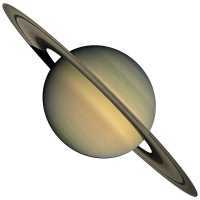Saturn is the sixth planet from the Sun and the most distant that can be seen with the naked eye. Saturn is the second largest planet and is best known for its fabulous ring system that was first observed in 1610 by the astronomer Galileo Galilei. Like Jupiter, Saturn is a gas giant and is composed of similar gasses including hydrogen, helium and methane.
Saturn Planet Profile
Equatorial Diameter: 120,536 km
Polar Diameter: 108,728 km
Mass: 5.68 × 10^26 kg (95 Earths)
Moons: 62 (Titan, Enceladus, Iapetus & Rhea)
Rings: 30+ (7 Groups)
Orbit Distance: 1,426,666,422 km (9.54 AU)
Orbit Period: 10,756 days (29.5 years)
Effective Temperature: -178 °C
First Record: 8th century BC
Recorded By: Assyrians

Enjoy being online again!
Welcome to the community of good people who base their values on evidence and appreciate civil discourse - the social network you will enjoy.Create your free account
Recent Visitors 2
Photos 424 More
Posted by starwatcher-alThe occultation of Mars on the 7th.
Posted by starwatcher-alThe occultation of Mars on the 7th.
Posted by starwatcher-alSolar minimum was in 2019 so the sun is ramping up in flares, spots and prominences.
Posted by starwatcher-alI missed the early phases of the eclipse but the clouds mostly left during totality. All in all a great eclipse. Next one is Nov. 8-22
Posted by starwatcher-alI missed the early phases of the eclipse but the clouds mostly left during totality. All in all a great eclipse. Next one is Nov. 8-22
Posted by RobecologyFor those following the JWST.
Posted by AnonySchmoose The post-launch set-up of the new James Webb telescope has gone very well.
Posted by HumanistJohnImages taken with Stellina (80 mm): M33 Triangulum Galaxy M1 Crab Nebula NGC281 Pacman Nebula in Cassiopeia NGC 6992 Veil Nebula in Cygnus
Posted by HumanistJohnImages taken with Stellina (80 mm): M33 Triangulum Galaxy M1 Crab Nebula NGC281 Pacman Nebula in Cassiopeia NGC 6992 Veil Nebula in Cygnus
Posted by HumanistJohnImages taken with Stellina (80 mm): M33 Triangulum Galaxy M1 Crab Nebula NGC281 Pacman Nebula in Cassiopeia NGC 6992 Veil Nebula in Cygnus
Posted by HumanistJohnImages taken with Stellina (80 mm): M33 Triangulum Galaxy M1 Crab Nebula NGC281 Pacman Nebula in Cassiopeia NGC 6992 Veil Nebula in Cygnus
Posted by HumanistJohnImages taken October 2nd 2021 with Stellina 1.
Posted by HumanistJohnImages taken October 2nd 2021 with Stellina 1.
Posted by HumanistJohnImages taken October 2nd 2021 with Stellina 1.
Posted by starwatcher-al Did you know that you can see Venus in the daytime?
Posted by starwatcher-alOne of these days I think that I'll figure out this Nikon.







